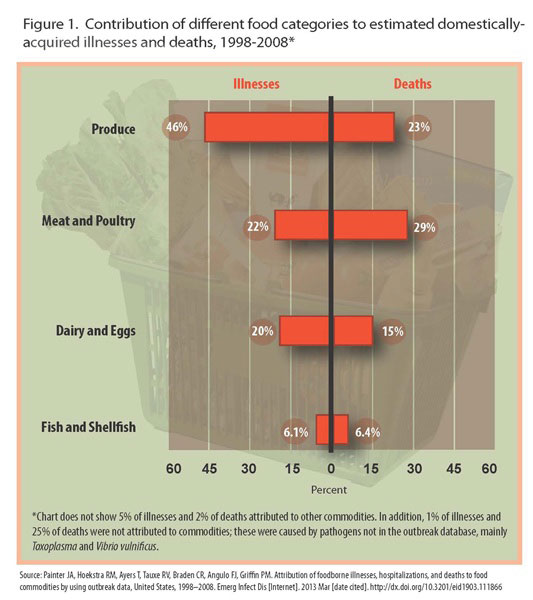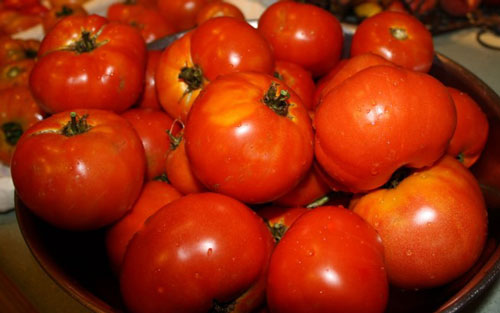Consumer FAQs
- What Causes Foodborne Illness?
- What are Symptoms of Foodborne Illness?
- What Food Categories are Linked to Foodborne Illnesses?
- What Causes Outbreaks in Produce?
- Other FAQ resources…
What Causes Foodborne Illness?
Foodborne illness is caused specifically from eating foods that harbor disease-causing microorganisms (pathogens). Some of the common ones we hear about in the news are Salmonella, Listeria, E. coli O157:H7 and Yersinia. These bacteria are found in many different places in the environment and can contaminate food through contact with contaminated water, soil, humans, and animals, to name a few. Basically, foodborne pathogens are everywhere! Unfortunately, you cannot smell, taste or see them. Unlike spoilage microorganisms that spoil our food (think curdled milk!), pathogens do not change the composition of the food at all, making it really difficult to know if they are present.
- Common foodborne pathogens: Salmonella
- Common foodborne pathogens: Staphylococcus aureus
- Common foodborne pathogens: Listeria monocytogenes
- Common foodborne pathogens: E. coli
- Common foodborne pathogens: Clostridium botulinum
What are Symptoms of Foodborne Illness?
Most foodborne illness is self-limiting, meaning that it just goes away on its own without any medical intervention. Typical symptoms include diarrhea (which is the number one symptom), vomiting, nausea, abdominal pain, and fever, with certain types of illnesses. However, in certain population groups, more severe complications can result from foodborne illnesses. Some examples include: “reactive arthritis”, a type of arthritis that can occur after certain foodborne illnesses; Guillain-Barre syndrome, which is a type of muscle weakness or paralysis; spontaneous abortions, stillbirths or deaths of infants after birth that can result if pregnant women become infected from Listeria monocytogenes; and Hemolytic Uremic Syndrome (HUS), the leading cause of kidney failure in young children. The most at-risk groups for developing serious complications are young children, pregnant women, older adults and people who are already suffering from diseases like diabetes or are on chemotherapy for cancer that has weakened their immune systems.
What Food Categories are Linked to Foodborne Illnesses?
While foodborne illness can come from any food commodity, there are some foods in which foodborne illness occurs more commonly. In the figure below, the most recent data shows that contaminated produce was responsible for 46% of the illnesses. With the increased consumption of fresh fruits and vegetables, and the incidence of foodborne illnesses, this is why we spend so much time focused on educating about the food safety best practices for growing and handling fresh produce.

What Causes Outbreaks in Produce?
While people often assume that outbreaks are mainly caused by imported produce, the fact is the majority (75%) of U.S. outbreaks come from domestically- grown produce. Many people wonder why consumption of produce is attributed to so many illnesses. The problem is that once produce is contaminated by pathogens, it is difficult, if not impossible, to remove the contamination. This is because many plants have cracks and crevices in which pathogens can attach and penetrate internal tissues of the produce and be protected from practices like washing. Here are a few examples:
- Leaves (lettuce, spinach, etc.) have very tiny (almost invisible) openings for gas exchange called stomata. The plant takes in carbon dioxide and gives off oxygen and water vapor through these openings. At these openings, water can accumulate. If the water contains foodborne pathogens, they can attach to these small openings, where they are then protected and penetrate inside the plant tissue.
 Tomatoes have a porous stem scar where, under the right conditions, pathogens (if present on the surface of the tomato, or in the wash water) can move into the pulp of the fruit, where they can grow and are protected from washing.
Tomatoes have a porous stem scar where, under the right conditions, pathogens (if present on the surface of the tomato, or in the wash water) can move into the pulp of the fruit, where they can grow and are protected from washing. - Cantaloupes are a great example of a fruit that has a stem scar and also has a netted rind. Because of these features, cantaloupes can be problematic by allowing contaminated water to enter into the fruit. In fact, this is one reason why when cutting a cantaloupe, you may have heard about making sure to be careful of not exposing any dirt on the surface of the rind to the inside with a knife.

- Frequently Asked Questions from the University of Nebraska-Lincoln Institute of Agriculture and Natural Resources:
This site includes answers to a variety of questions including how to keep foods safe during a power outage; safety of dented or rusted canned food; and how to understand food product date labels. - Frequently Asked Questions from the National Center for Home Food Preservation
Has a list of topics, as well as a topics search feature.
